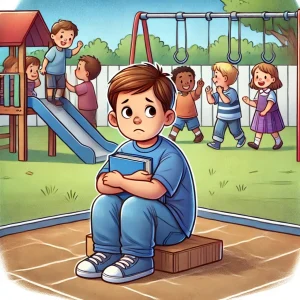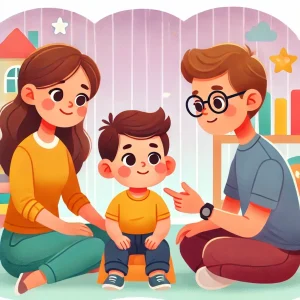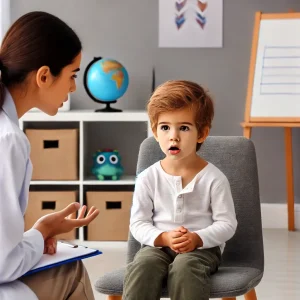Help Kids with Autism Talk Clearly: Overcome Apraxia of Speech
By Rajini D
Last Updated: May 3, 2024
Have you ever noticed your child struggling to say what they clearly want to express, or perhaps their words just don’t come out right? If so, they might be facing challenges associated with speech apraxia, a condition notably prevalent among children with autism. Speech apraxia affects the brain’s ability to coordinate the muscle movements necessary for speech. It’s not just about difficulty in speaking but about making the precise movements that form speech.
For families navigating the complexities of autism, understanding and addressing speech apraxia can play a crucial role in enhancing communication skills. Early intervention is key. The sooner the intervention begins, the better the outcomes in speech clarity and communication effectiveness. Tailoring support to meet the unique needs of each child can transform these challenges into growth opportunities, paving the way for more effective communication.
Understanding Speech Apraxia and Autism
What is Speech Apraxia?
Speech apraxia is a motor speech disorder that makes it hard for children to speak. This isn’t just about finding the right words but involves planning and coordinating the movements needed to make sounds. For a child with speech apraxia, even if they know what they want to say, their brain struggles to communicate with their mouth to form those words correctly. This can result in jumbled or incomplete sounds, which can be frustrating for both the child and the listener.
Autism and Communication
Autism, or Autism Spectrum Disorder (ASD), affects how individuals perceive the world and interact with others, with communication being one of the primary areas impacted. Children with autism may have trouble with both verbal and non-verbal communication. They might not speak at all, or they could use words repetitively and not in the way typically developing children do. For these children, understanding and being understood by others can be a daily challenge.
Also read: Unlocking Communication: Effective Speech Therapy for Autism
The Link Between Speech Apraxia and Autism
While not every child with autism experiences speech apraxia, there’s a notable overlap that has caught the interest of many researchers. Recent studies suggest that children with autism are more likely to show signs of apraxia. This dual challenge can intensify communication difficulties, making typical speech therapy approaches less effective.
Signs of Speech Apraxia in Children with Autism:
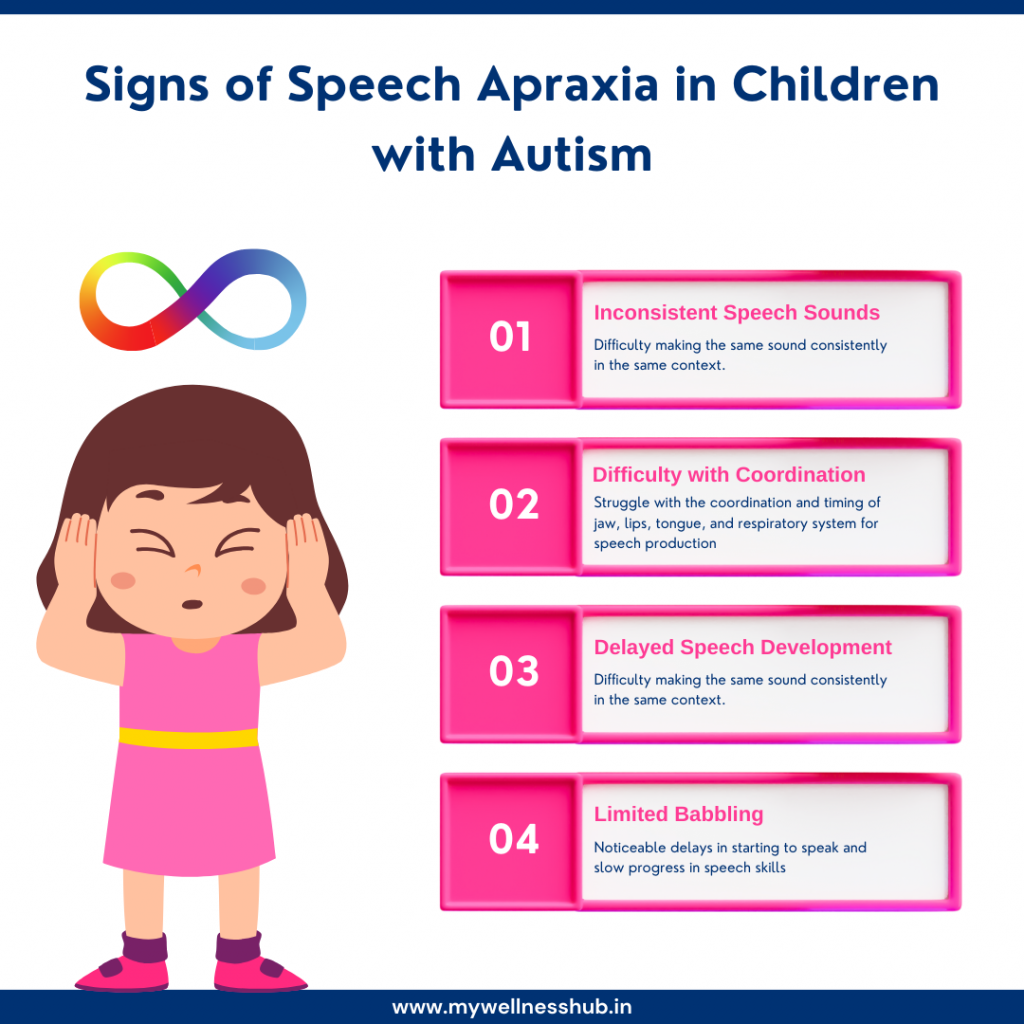
Identifying speech apraxia in children, especially those with autism, can be challenging due to the complex nature of both conditions. However, recognizing the signs early can lead to timely and effective intervention. Here are some common symptoms of speech apraxia in children with autism:
- Inconsistent Speech Sounds: The child may not consistently say the same words the same way each time, which can make their speech unpredictable and difficult to understand.
- Difficulty with Coordination: They may struggle to move their lips, jaw, or tongue to the right position to say sounds, which can lead to delayed speech or inability to speak clearly.
- Groping Movements: You might notice that your child appears to be searching for the correct mouth position when trying to speak.
- Limited Babbling: In younger children, you might observe less babbling than is typical, or the babbling may lack the usual variety of sounds.
- Delayed Language Development: They might speak later than expected, or their speech development might plateau or regress.
Quick Checklist to Identify Speech Apraxia: To help you determine if your child might be showing signs of speech apraxia, consider these questions:
- Does your child try to speak, but only a few sounds or silent movements come out?
- Are your child’s attempts at words hard to understand, even for familiar listeners?
- Does your child show frustration when trying to communicate verbally?
- Have you noticed improvements in how your child says a word one day, but then it seems they can’t replicate it the next?
Know more: Understanding Speech Patterns in Autism
Early Intervention: Why It’s Crucial
The Power of Early Diagnosis
Recognizing and addressing speech apraxia as early as possible is crucial, especially in children with autism. An early diagnosis of speech apraxia can set the foundation for effective treatment plans and, importantly, prevent further complications in speech and language development. Early detection allows for interventions that are tailored to each child’s specific needs, potentially making a significant difference in their overall communication abilities.
Benefits of Timely Support
Timely intervention is not just about speech therapy; it’s about opening doors to more effective communication, which is vital for a child’s social and academic success. Here’s how early intervention can transform a child’s ability to communicate:
- Enhanced Learning Opportunities: When children can express themselves clearly, they engage more fully in learning environments, both at school and at home.
- Social Skills Development: Improved communication skills allow children to interact more effectively with their peers, fostering better relationships and enhancing social learning.
- Reduced Frustration: Children who struggle to communicate often experience significant frustration. Early intervention can reduce this by providing them with tools to express themselves more clearly.
- Building Confidence: As children see their own progress, their confidence in their ability to communicate grows. This self-assurance can spill over into other areas of their lives, encouraging more active participation in various activities.
Read more about The Crucial Role of Parents in Online Speech Therapy
Diagnosis and Professional Support
Getting a Professional Diagnosis
If you suspect your child may have speech apraxia, especially if they are on the autism spectrum, the first step is to consult a qualified speech-language pathologist (SLP). This professional will conduct a comprehensive evaluation to assess your child’s communication abilities and challenges. Here’s what you can expect during the diagnostic process:
- Initial Consultation: This involves discussing your child’s medical history, developmental milestones, and any concerns you have about their speech and language development.
- Observation and Testing: The SLP will observe how your child communicates in different settings and may use standardized tests to evaluate speech clarity, language comprehension, and speech production capabilities.
- Specific Assessments for Apraxia: To diagnose speech apraxia, the SLP might perform additional assessments that look at how your child plans and executes speech movements.
- Feedback and Recommendations: After the evaluation, you will receive a detailed feedback session where the SLP will discuss the findings and suggest a plan for intervention.
Speech Apraxia vs. Other Speech Disorders
| Disorder | Symptoms | Treatment Approaches |
|---|---|---|
| Speech Apraxia | Difficulty coordinating muscle movements needed for speech, inconsistent speech sounds, struggle with complex word sounds. | Speech therapy focuses on repetitive practice, motor planning, and multisensory cues. |
| Dysarthria | Slow, slurred, and often mumbled speech due to muscle weakness. Difficulty controlling the muscles used for speech. | Speech therapy includes exercises to strengthen the muscles used for speaking, improve breath support, and increase speech clarity. |
| Phonological Disorders | Patterns of sound errors, such as simplifying complex sounds (e.g., replacing ‘tree’ with ‘tee’). Less related to muscle control and more to understanding the sound rules of a language. | Speech therapy focuses on teaching the correct production of sounds, understanding and using language rules more effectively. |
Treatment Strategies for Speech Apraxia in Children with Autism
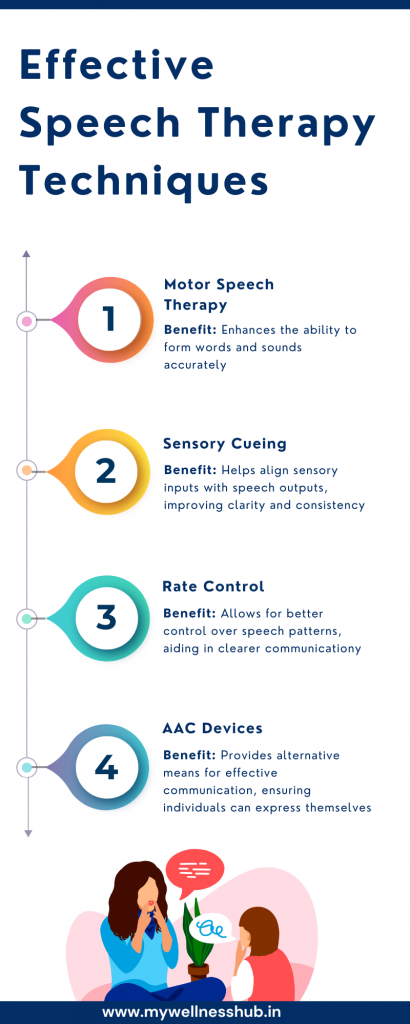
Tailored Speech Therapy Techniques
Speech therapy is the cornerstone of treating speech apraxia, and when it comes to children with autism, the approach needs to be highly personalized. Here are some specific techniques that speech-language pathologists (SLPs) might use:
- Motor Planning and Sequencing: Exercises that help the child practice the movement patterns necessary for speech.
- Repetitive Practice: Using frequent repetition to help the child learn to produce sounds and words more automatically and consistently.
- Visual and Auditory Cues: Incorporating tools like mirrors or recordings can help the child see and hear their own production, making adjustments easier.
- Multi-sensory Approaches: These might include touch cues on the face to guide movements, or using gestures to support the development of speech sounds.
The Role of Multidisciplinary Teams
Managing speech apraxia often requires more than just speech therapy, especially in children with autism. A multidisciplinary team approach can be highly effective:
- Occupational Therapists: Can help improve the child’s motor skills and coordination, which are crucial for speech production.
- Behavior Analysts: Might work on supporting behavior changes that encourage communication, such as reducing frustration-related behaviors that interfere with therapy.
- Special Education Teachers: Collaborate in creating educational plans that incorporate the child’s communication needs into the learning environment.
Explore more about our article: Overcome Speech Apraxia in Kids: Effective Strategies
Practical Tips for Parents
As a parent, you play a critical role in your child’s treatment plan. Here are some practical ways you can support your child’s therapy goals at home:
- Consistent Practice: Reinforce the exercises and techniques that the therapist uses during sessions. Consistency helps translate skills learned in therapy to everyday situations.
- Create a Communication-friendly Environment: Encourage communication through pictures, signs, or devices if your child also uses these for support.
- Stay Engaged with the Therapists: Regular updates from your child’s therapists can help you understand progress and adapt strategies as needed.
- Celebrate Small Wins: Every little improvement is a step forward and celebrating these can motivate your child to keep trying.
Conclusion
We’ve covered a lot about helping children with autism overcome speech apraxia. It’s a journey full of challenges but also filled with rewarding milestones. From understanding the signs and the importance of early intervention to professional diagnosis and effective treatments, every step you take plays a crucial role in your child’s development. Remember, each small success in improving communication is a big win worth celebrating.
If you ever feel unsure about what to do next, remember you’re not alone. Wellness Hub is here to offer tailored advice and support. Our experts are ready to help you fine-tune your child’s therapy plan and provide the resources you need to succeed. For more guidance or to connect with a specialist, visit our Support Services page. Let’s work together to give your child the best tools to express themselves and connect with the world.
Frequently Asked Questions:
1. What is speech apraxia in children with autism?
Speech apraxia is a motor speech disorder where children with autism struggle to plan and produce the precise movements needed for speech. It results in inconsistent speech sounds and difficulty forming words clearly.
2. How can I tell if my child with autism has speech apraxia?
Signs of speech apraxia include inconsistent speech sounds, difficulty coordinating mouth movements, limited babbling in toddlers, and a delay in speech development. If your child shows these signs, consider consulting a speech-language pathologist.
3. Why is early intervention important for children with autism and speech apraxia?
Early intervention is crucial as it can significantly improve a child’s speech clarity and communication skills over time. Starting therapy early helps capitalize on the brain’s adaptability and can prevent further speech and language complications.
4. What are some effective speech therapy techniques for children with apraxia and autism?
Effective techniques include motor planning and sequencing activities, repetitive practice to build muscle memory, and multisensory approaches, such as visual and tactile cues, to support speech production.
5. What role do parents play in the treatment of speech apraxia in autistic children?
Parents are essential in reinforcing therapy goals at home, providing consistent practice, and creating a supportive communication environment. Engaging with therapists and following through with recommended activities at home are key to successful outcomes.
6. Where can I find professional support for my child with autism and speech apraxia?
Professional support can be found through speech-language pathologists, occupational therapists, and special education programs. Wellness Hub offers access to specialized therapists and resources tailored to children with speech apraxia and autism.
7. How often should a child with autism and speech apraxia attend speech therapy?
The frequency of speech therapy sessions can vary based on the child’s specific needs and the severity of speech apraxia. Typically, therapists recommend sessions ranging from once to multiple times a week, with adjustments based on progress and individual response to therapy.
8. Can speech apraxia in children with autism improve over time?
Yes, with appropriate therapy and support, speech apraxia can improve over time. Progress may be gradual, and the rate of improvement varies from child to child. Consistent therapy, home practice, and the use of supportive tools and techniques are crucial for development.
9. What are some home activities that can support speech therapy for apraxia?
- Home activities that can support speech therapy include:
- Singing songs that emphasize different sounds and lip movements.
- Reading books with repetitive phrases to practice sounds and rhythm.
- Using mirror exercises to help the child see how they form words and sounds.
- Playing games that involve taking turns and mimicking sounds or words.
10. How do I choose the right speech-language pathologist for my child with autism and apraxia?
When choosing a speech-language pathologist (SLP), look for professionals who have specific experience and training in both autism and speech apraxia. It’s also beneficial to choose someone who uses evidence-based practices and whom your child feels comfortable with. Often, recommendations from other parents, your child’s pediatrician, or autism support groups can lead you to the right specialist.
About the Author:
Rajini Darugupally
M.Sc., Speech-Language Pathologist (9+ years of experience)
Rajini is a passionate and dedicated Speech-Language Pathologist with over 9+ years of experience, specializing in both developmental speech and language disorders in children and rehabilitation in adults. Driven by a desire to empower each individual to find their voice, Rajini brings a wealth of experience and a warm, genuine approach to therapy.
Currently, at Wellness Hub, she thrives in a team environment that values innovation, compassion, and achieving results for their clients.
Connect with Rajini to learn more about how she can help you or your loved one find their voice.
Book your Free Consultation Today
Parent/Caregiver Info:
Client’s Details:
* Error Message
